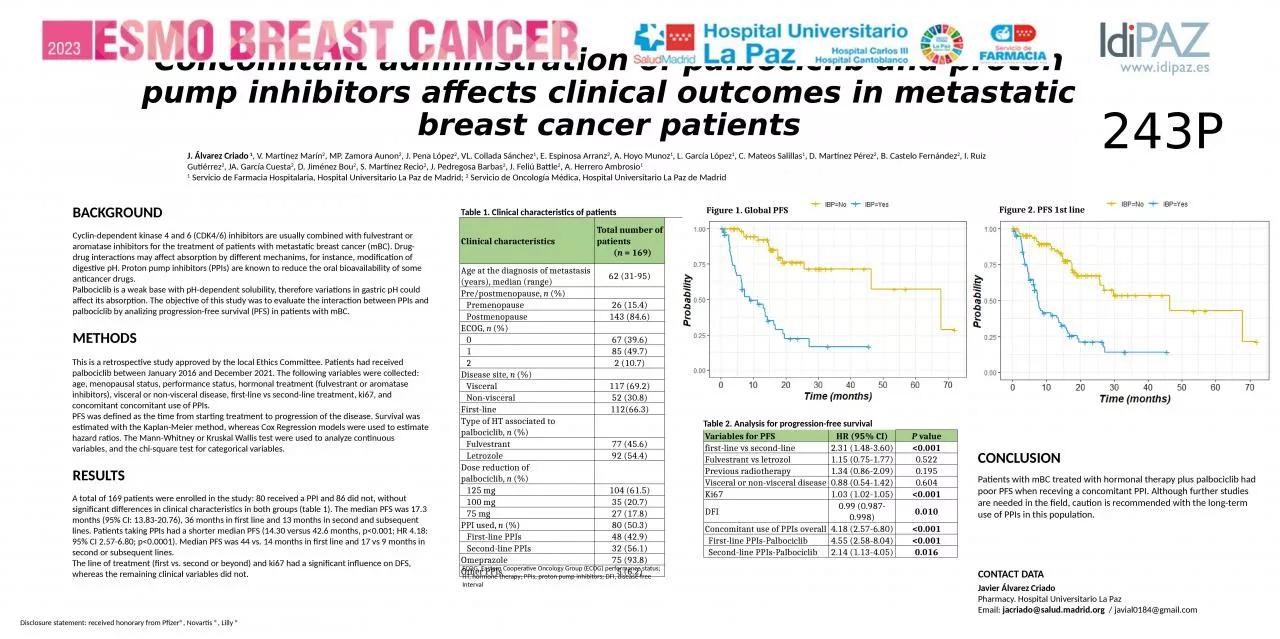

Cyclindependent kinase 4 and 6 CDK46 inhibitors are usually combined with fulvestrant or aromatase inhibitors for the treatment of patients with metastatic breast cancer mBC Drugdrug interactions may affect absorption by different ID: 1037630
Download Presentation The PPT/PDF document "Concomitant administration of palbocicli..." is the property of its rightful owner. Permission is granted to download and print the materials on this web site for personal, non-commercial use only, and to display it on your personal computer provided you do not modify the materials and that you retain all copyright notices contained in the materials. By downloading content from our website, you accept the terms of this agreement.
1. Concomitant administration of palbociclib and proton pump inhibitors affects clinical outcomes in metastatic breast cancer patientsCyclin-dependent kinase 4 and 6 (CDK4/6) inhibitors are usually combined with fulvestrant or aromatase inhibitors for the treatment of patients with metastatic breast cancer (mBC). Drug-drug interactions may affect absorption by different mechanims, for instance, modification of digestive pH. Proton pump inhibitors (PPIs) are known to reduce the oral bioavailability of some anticancer drugs.Palbociclib is a weak base with pH-dependent solubility, therefore variations in gastric pH could affect its absorption. The objective of this study was to evaluate the interaction between PPIs and palbociclib by analizing progression-free survival (PFS) in patients with mBC.BACKGROUNDThis is a retrospective study approved by the local Ethics Committee. Patients had received palbociclib between January 2016 and December 2021. The following variables were collected: age, menopausal status, performance status, hormonal treatment (fulvestrant or aromatase inhibitors), visceral or non-visceral disease, first-line vs second-line treatment, ki67, and concomitant concomitant use of PPIs.PFS was defined as the time from starting treatment to progression of the disease. Survival was estimated with the Kaplan-Meier method, whereas Cox Regression models were used to estimate hazard ratios. The Mann-Whitney or Kruskal Wallis test were used to analyze continuous variables, and the chi-square test for categorical variables.METHODSA total of 169 patients were enrolled in the study: 80 received a PPI and 86 did not, without significant differences in clinical characteristics in both groups (table 1). The median PFS was 17.3 months (95% CI: 13.83-20.76), 36 months in first line and 13 months in second and subsequent lines. Patients taking PPIs had a shorter median PFS (14.30 versus 42.6 months, p<0.001; HR 4.18: 95% CI 2.57-6.80; p<0.0001). Median PFS was 44 vs. 14 months in first line and 17 vs 9 months in second or subsequent lines.The line of treatment (first vs. second or beyond) and ki67 had a significant influence on DFS, whereas the remaining clinical variables did not.RESULTSECOG, Eastern Cooperative Oncology Group (ECOG) performance status; HT, hormone therapy; PPIs, proton pump inhibitors; DFI, disease-free Interval Table 1. Clinical characteristics of patientsClinical characteristicsTotal number of patients (n = 169) Age at the diagnosis of metastasis (years), median (range)62 (31-95) Pre/postmenopause, n (%) Premenopause26 (15.4) Postmenopause143 (84.6) ECOG, n (%) 067 (39.6) 185 (49.7) 22 (10.7) Disease site, n (%) Visceral117 (69.2) Non-visceral52 (30.8) First-line112(66.3) Type of HT associated to palbociclib, n (%) Fulvestrant77 (45.6) Letrozole92 (54.4) Dose reduction of palbociclib, n (%) 125 mg104 (61.5) 100 mg35 (20.7) 75 mg27 (17.8) PPI used, n (%)80 (50.3) First-line PPIs48 (42.9) Second-line PPIs32 (56.1) Omeprazole75 (93.8) Other PPIs 5 (6.2) Table 2. Analysis for progression-free survivalPatients with mBC treated with hormonal therapy plus palbociclib had poor PFS when receving a concomitant PPI. Although further studies are needed in the field, caution is recommended with the long-term use of PPIs in this population.CONCLUSIONVariables for PFSHR (95% CI)P valuefirst-line vs second-line2.31 (1.48-3.60)<0.001Fulvestrant vs letrozol1.15 (0.75-1.77)0.522Previous radiotherapy1.34 (0.86-2.09)0.195Visceral or non-visceral disease0.88 (0.54-1.42)0.604Ki671.03 (1.02-1.05)<0.001DFI0.99 (0.987-0.998)0.010Concomitant use of PPIs overall4.18 (2.57-6.80)<0.001First-line PPIs-Palbociclib4.55 (2.58-8.04)<0.001Second-line PPIs-Palbociclib2.14 (1.13-4.05)0.016Figure 1. Global PFSFigure 2. PFS 1st lineDisclosure statement: received honorary from Pfizer®, Novartis ®, Lilly ® Javier Álvarez CriadoPharmacy. Hospital Universitario La PazEmail: jacriado@salud.madrid.org / javial0184@gmail.comCONTACT DATA243PJ. Álvarez Criado 1, V. Martínez Marín2, MP. Zamora Aunon2, J. Pena López2, VL. Collada Sánchez1, E. Espinosa Arranz2, A. Hoyo Munoz1, L. García López1, C. Mateos Salillas1, D. Martínez Pérez2, B. Castelo Fernández2, I. Ruiz Gutiérrez2, JA. García Cuesta2, D. Jiménez Bou2, S. Martínez Recio2, J. Pedregosa Barbas2, J. Feliú Battle2, A. Herrero Ambrosio11 Servicio de Farmacia Hospitalaria, Hospital Universitario La Paz de Madrid; 2 Servicio de Oncología Médica, Hospital Universitario La Paz de Madrid